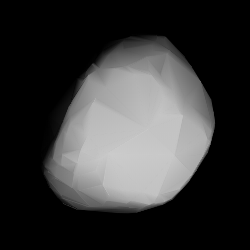 Shape model of Nancita from its lightcurve | |
| Discovery [1] | |
|---|---|
| Discovered by | E. Helin |
| Discovery site | Palomar Obs. |
| Discovery date | 13 March 1988 |
| Designations | |
| (4222) Nancita | |
Named after | Nancy Coker Helin (discoverer's family) [2] |
| 1988 EK1 ·1950 TF4 1952 HN ·1968 QL1 1972 XQ1 ·1979 SL6 1983 XC1 ·1988 KL | |
| Mars-crosser ex main-belt ·(inner) | |
| Orbital characteristics [1] | |
| Epoch 4 September 2017 (JD 2458000.5) | |
| Uncertainty parameter 0 | |
| Observation arc | 48.77 yr (17,813 days) |
| Aphelion | 3.0666 AU |
| Perihelion | 1.6705 AU |
| 2.3685 AU | |
| Eccentricity | 0.2947 |
| 3.65 yr (1,331 days) | |
| 104.75° | |
| 0° 16m 13.44s / day | |
| Inclination | 3.7412° |
| 206.85° | |
| 217.61° | |
| Mars MOID | 0.1710 AU |
| Physical characteristics | |
| 8.47±0.8 km (IRAS:11) [3] 9.14±0.71 km [4] 9.636±0.121 [5] 9.707±0.215 km [6] | |
| 3.8732±0.0003 h [7] | |
| 0.2057±0.0073 [6] 0.209±0.013 [5] 0.232±0.038 [4] 0.2703±0.061(IRAS:11) [3] | |
| SMASS = S [1] [8] | |
| 12.3 [1] ·12.4 [8] [3] [4] [6] | |
4222 Nancita (prov. designation: 1988 EK1) is a bright background asteroid and upcoming Mars-crosser on an eccentric orbit from the inner regions of the asteroid belt. It was discovered on 13 March 1988, by American astronomer Eleanor Helin at Palomar Observatory in California, United States. [9] The S-type asteroid has a rotation period of 3.9 hours and measures approximately 9 kilometers (5.6 miles) in diameter. It was named after the discoverer's daughter-in-law, Nancy Coker Helin.